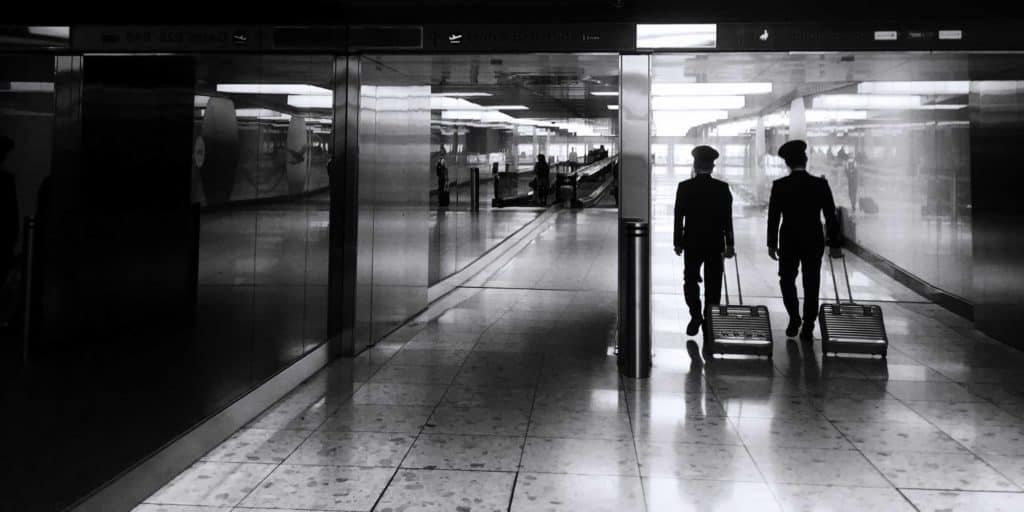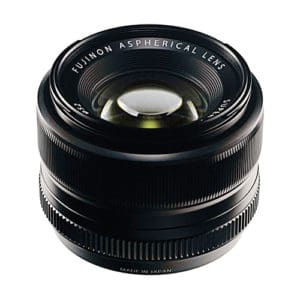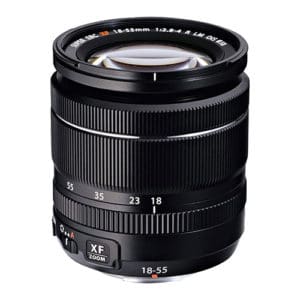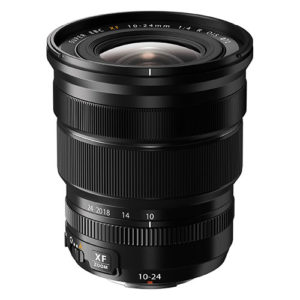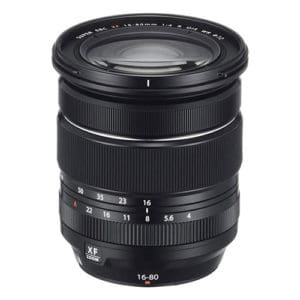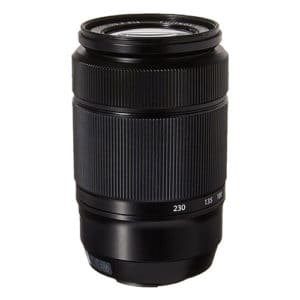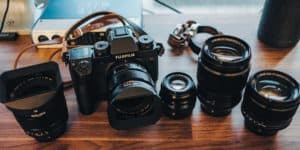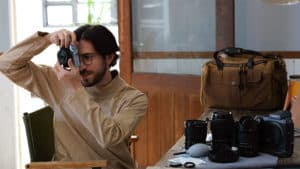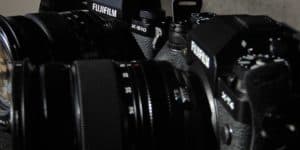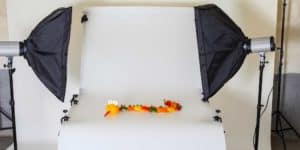Whether you’re looking for a compact lens you can fit in your pocket or a long telephoto that’ll capture moments from afar, you’ll still find plenty of reasons to take your Fuji camera out into the streets.
In this article, we dive into several types of lenses, all with their own benefits when it comes to street photography.
I’ll compare high-end and budget options for Fuji X-mount mirrorless cameras, and ultimately let you decide what’ll be best for your circumstances.
Why I picked it:
Nice and bright, this 23mm lens made by Fuji is a great lens for shooting street photography.
It has fast autofocus that, when combined with its low aperture, means you can capture things in-the-moment with little worry of motion blur.

Let’s dive a little deeper:
You might notice as you read through this list that all of my recommended lenses are made by Fuji.
I am in love with their lens lineup build quality, and value.
Thanks to the versatility of street photography (you can use many types of lenses) you can find a Fuji lens for almost every scenario.
Their 23mm prime lens is perhaps my favorite.
Why do I like it so much? It shoots fast thanks to its ultra-low aperture and its responsive autofocus, which means you won’t be struggling to focus in on a shot when it matters most.
Best of all, it’s a 23mm prime lens, so it’s ultra-compact; whether it’s on your camera or in your bag it won’t take up much room or get in the way.
This is a prime lens that can be used for all around street shots, including in low light or late night.
It’s versatile and benefits from the excellent craftsmanship of the Fuji brand.
Quick Look:
- A fast aperture of f/1.4 means this camera won’t miss anything no matter how fast it moves
- The lens’s low profile makes it easy to carry, whether it’s on your camera or in your bag
- Super-fast autofocus takes the guesswork out of capturing crisp photos in-the-moment
- Aperture ring makes it trivial to change your aperture on-the-fly
- A little pricey but could potentially replace 2 or 3 lesser lenses in the same or similar category
Why I picked it:
If you’re a street photographer that likes to stand back a bit when shooting your subjects, then a 50 mm “mid-telephoto” lens (on fuji x-mount APSC sized sensors) could very well be the only lens you carry.
It’s great for shooting mid-distance, which lends a candid quality to your photos.
Or get up close and soak up the details thanks to this lens’s clarity and focal length.
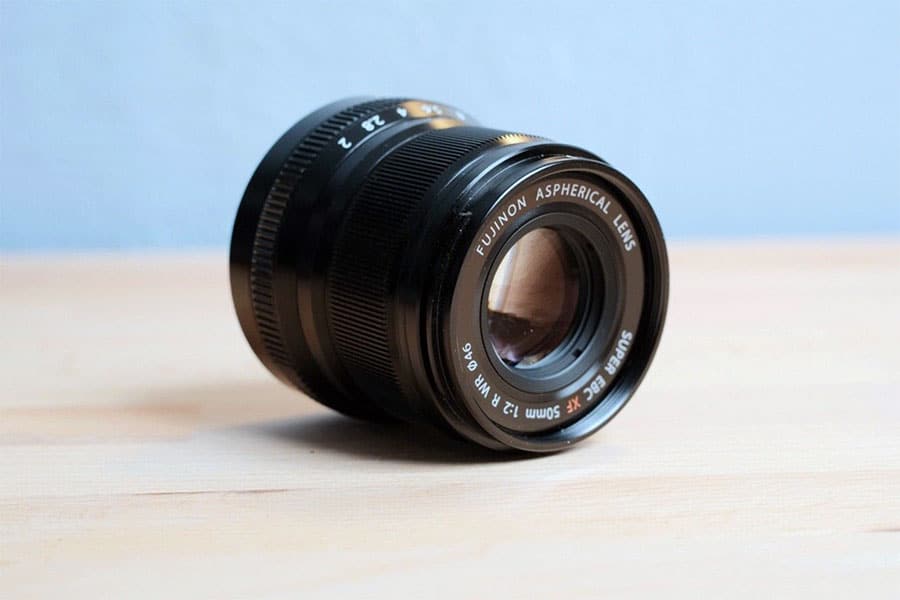
Let’s dive a little deeper:
Fuji touts this as a “mid-telephoto” lens, which makes sense. 50mm is a sweet spot between “close up” and “medium-range”, which when used creatively in a street photography setting can give you a flexibility that many other focal ranges can’t.
Realistically, this lens functions as a 76mm; get further away from your subject matter for a more candid look or get in close for a street portrait style.
Whatever the case, there’s plenty you can do with this lens.
Beyond its focal range, the lens is also dirt and water resistance so you can take it with you all around the city without worrying too much about the weather, just don’t get caught in a downpour.
Thanks to decades of experience, Fuji has manufactured a surprisingly lightweight lens for its size at just .70 pounds.
The autofocus on this camera is nearly silent and smooth.
Yet, manual focus is just as gratifying thanks to a seriously smooth focus and aperture rings.
Quick Look:
- 50mm puts this lens at the “mid-telephoto” length, which isn’t for everyone. But for those of us that like to shoot street photography from a distance or get close and detailed, then this lens is great.
- The lens’s all-metal body is both water and dust resistant.
- Autofocus is sharp and quick, manual focus is silky smooth
- For its price, this lens could be your go-to or just another tool in your arsenal based on your budget; it’s neither exorbitantly expensive nor cheap
Why I picked it:
Fuji calls this lens “the original” for a reason.
It’s their quintessential lens and it’s extremely versatile.
Fast, sharp, and shallow, this is a great choice for street photography.
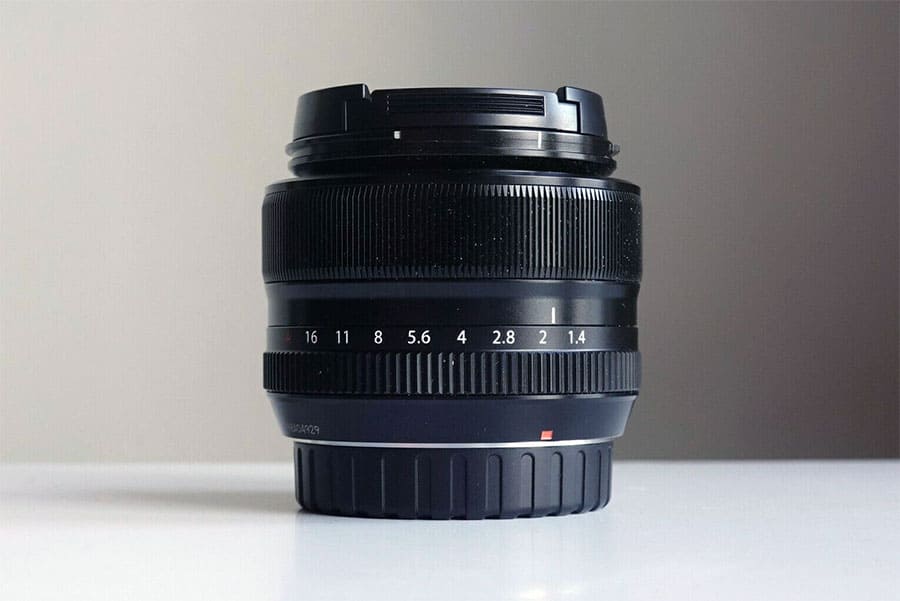
Let’s dive a little deeper: An aperture of f/1.4 makes this an extremely bright and fast lens, so street photography is easier than ever. “The original” 35mm lens by Fuji makes snapshots look like high art; all you have to do is aim and shoot.
In many cases, street photography is about putting as few obstacles between you and your subject as possible. Sometimes even your camera can get in your way if there’s too much to play around with when the moment is in motion. Keeping things simple but beautiful is exactly what this 35mm accomplishes.
If someone told me they could only own one sub $500 Fuji X-mount lens I would tell them to get this, no questions asked. If you’ve ever used Fuji’s classic 50mm, then you would see many similarities between it and this lens.
Quick Look:
- It’s fast, it’s bright, and it has superb autofocus, so snapshots look beautiful
- The 35mm is the perfect focal length for many varieties of photography
- With a minimum aperture of f/1.4 and a max aperture of f/16 you can still get creamy backdrops when shooting with a shallow depth-of-field
- At less than half a pound, this is a compact and lightweight lens to carry with you
I took this photo on a similar focal length lens just to give an idea.
Why I picked it:
Get close or stand back; this 18-55mm zoom lens gives you the versatility to move around in your street photography.
Sometimes having options is a good thing.
View this post on Instagram#streetphotography #streetphoto_bw #streetphoto #blackandwhitephoto #blackandwhiteonly
A post shared by Rudy Dewatine (@rudy.dew) on
Let’s dive a little deeper:
this is technically a “kit” zoom lens, but that doesn’t mean it’s not a great lens to carry around with you. The 18-55mm focal range means you can shoot up-close portraits on the street or step back and let the action unfold without interfering. Even at 55mm, you can still step into the moment.
With built-in image stabilization and smooth zoom, this is a great lens for filmmaking. For photography, it works extremely well in low light and has a fast autofocus so you can click away at your shutter and rest assured that what you’re capturing is crisp and clear. At .68 pounds, the lens is surprisingly lightweight for its size. It might be a bit bulky to carry around but it won’t weigh you down.
Thanks to its aspherical lens, you will be free of edge distortion even when you’re zoomed in. I love to use this lens for almost anything. For street photography, it can get you right into the moment no matter where you’re standing.
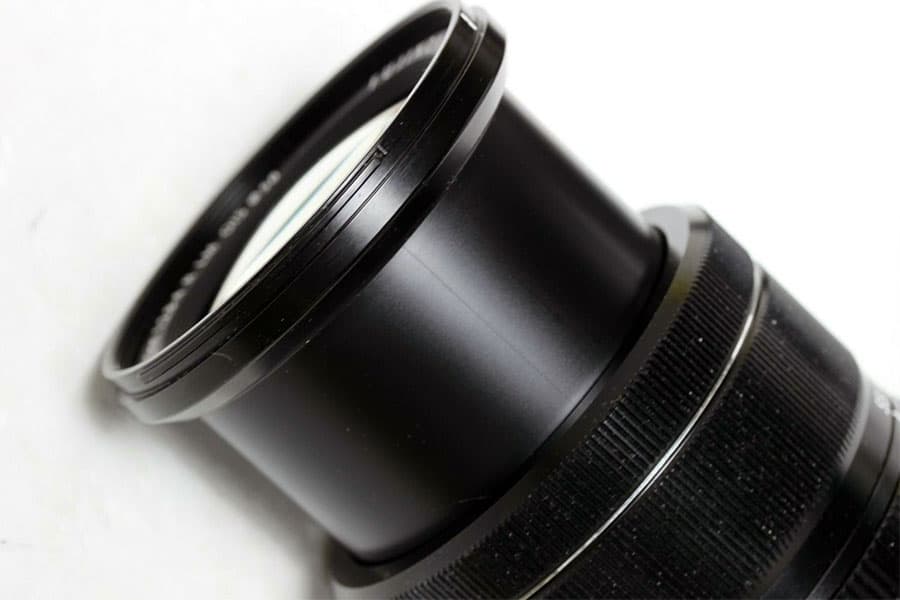
Quick Look:
- The 18-55mm focal length lets you get up close no matter what, whether you’re standing right there or at a distance
- Autofocus is nearly silent, manual focus is smooth; the lens also benefits from Fuji’s aperture ring for manual aperture control
- Lightweight but, due to its length, is not exactly compact
- Even zoomed in to 55mm this lens is relatively distortion-free
Why I picked it:
This is Fuji’s one-stop ultra-wide zoom option for its x-mount cameras.
It’s super clear, fast, and will allow your camera to see everything that’s in front of it.
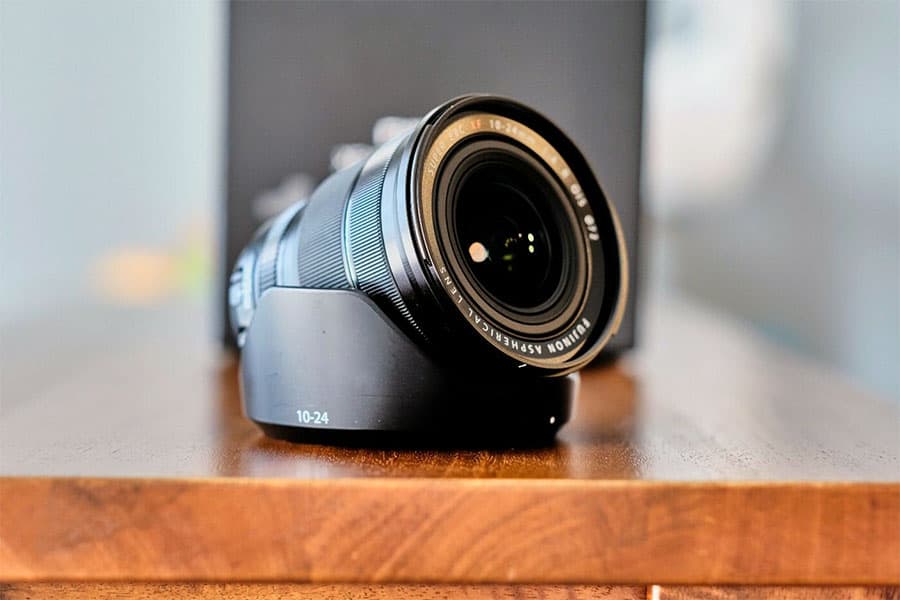
Let’s dive a little deeper:
This is such a neat lens. Touted as an ultra-wide-angle zoom lens, the 10-24mm will fit almost every detail into its picture. Wide-angle photos in street photography can be challenging; sometimes a wide-angle is simply boring. However, with the skill and intuition of a serious photographer, this ultra-wide-angle 10mm focal length can really make your imagery sing.
Best yet, when you zoom up to the upper limits of 24mm you have on your hands what could pass as a portrait lens. Shooting with this camera is a dream; you can get a little funky with it and just as easily zoom in for a more formal look.
This lens is so fast and bright that almost nothing in front of it is autofocus. As I said earlier, this can make your photos boring if used incorrectly. However, when used with precision this can lend a new angle (no pun intended) to your street photography.
Quick Look:
- A great little zoom lens that gives you both ultra-wide-angle and something that can pass as a portrait angle
- Autofocus is extremely fast on this lens; you can capture every moment as it happens
- At close to $1,000, this is a lens that you invest in and hopefully have a continuous use for
- This lens has very little distortion even at ultr
Why I picked it:
Just as I would consider the aforementioned Fuji 35mm a classic prime lens, I would consider this 16-80mm a classic Fuji zoom lens.
It’s a straightforward lens with no surprises; it just works extremely well and consistently.

Let’s dive a little deeper:
It’s relatively light and compact yet it offers a range to ensure that, no matter where you’re standing, you will have a way of capturing the moment.
This is perhaps the most reliable, multi-functional, and straightforward zoom lens in the Fuji arsenal.
Bokeh on this lens is great; the shallow depth of field gives your background a dreamy, ethereal look without any struggle.
Beyond that, the foreground is as crisp as it can get.
Autofocus on this lens is fast enough as to not be a worry.
Like most Fuji lenses in this category, it’s pretty much silent.
To be honest, I’d use this lens for street photography, portrait photography, and landscape photography; it simply covers the entire range without any struggle.
Quick Look:
- At 16-80mm, this is perhaps the most versatile zoom lens made by Fuji
- Fast autofocus means you won’t lose out on an opportunity to capture a moment
- Bokeh is smooth and silky.
- At 1 pound, the lens is a little on the heavy side but compact
Why I picked it:
While it’s not for everyone, sometimes a true telephoto lens can work for a street photographer who needs some distance between their camera and their subject.
This lens is a great place to start.
Let’s dive a little deeper:
You can’t beat a lens that gives you 50mm and up to 230mm for less than $500.
The 50-230mm telephoto lens for Fuji is a workhorse.
At 50mm this lens can function as a straightforward street lens. However, once you zoom in you will see that there is a whole world worth exploring from afar.
This is a long and slow lens, which means you won’t get super creamy bokeh out of it. However, its sheer versatility makes up for it. This could be the only lens in your arsenal, as long as you understand how to use it to its full potential.
Quick Look:
- At 50mm this lens functions well for street and portrait photography, when used at 230mm it can be used for many other purposes
- Autofocus is fast enough but could be faster
- The slow speed of this camera means you won’t get outstanding bokeh
- This lens isn’t super bright at a minimum aperture of f/4.5
Street Photo FAQ's
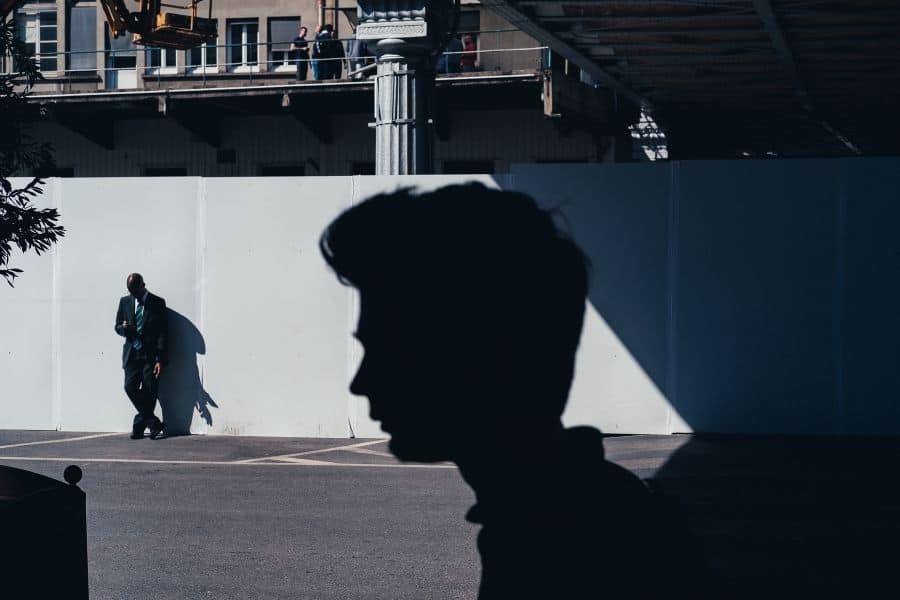
What is Aperture (f/stop) and how much does it matter for street photographers?
When you see the “f/stop” setting on your camera it is referring to the camera’s aperture.
What is aperture, exactly?
In technical terms, it’s the size of the opening of the camera’s diaphragm.
Lower aperture numbers bring in more light and higher settings bring in less.
More light means more exposure; brighter photos that preserve action. Less light means less exposure, which means clearer, richer photos if you hold your camera steady with a tripod.
The lower your aperture, the more bokeh (background blur) you will have.
Most importantly for street photography, you will also be able to shoot at higher speed, to “freeze” the moment.
Useful when trying to take a picture of people walking or generally moving things.
It becomes even more useful in low light situations, where with a bright lens you will be able to use a higher shutter speed and avoid motion blur.
When & What is the “Golden Hour”?
The golden hour occurs right before sunup and right before sundown.
To define it does it little justice; it’s much easier to understand why it’s so magical by witnessing it with your own eyes. However, to describe it, you could say that, as the sun sits above the horizon it projects a warm yet vibrant glow over everything. Shadows deepen and the rich, orange light is profound and vivid against your model and your backdrop.
It’s easy to take stunning photos during these “golden hours”, which is why they are so popular.
What is the “Rule of Thirds” in Photography?

The “rule of thirds” is a compositional principle applied to almost all visual art styles, photography included.
To put it simply, imagine that you’re breaking down the image seen through your viewfinder or on your camera screen into 9 separate sections in a grid.
Using the rule of thumbs, your subject matter should cleanly align with that imaginary grid.
Of course, all rules are meant to be broken, but no one can deny that a photograph that follows this rule will look better compositionally than many photographs that ignore it.
When Should I Use a Telephoto Lens for Street Photography?
Much of street photography is intimate; it’s taken close up and it captures a sequence of action. Part of the pleasure of street photography is the idea that you’re preserving a moment in time that would otherwise be lost. However, a telephoto lens can still be a great asset to you when used well. Sometimes it’s good to be a “fly on the wall” observer. In street photography, there is no better way to convey this than by standing at a distance and capturing your subject through a telephoto lens. Street photography taken in this way is candid, mysterious, and forces the audience to observe rather than take part.
Is Image Stabilization (OIS) Important in Street Photography?
To be honest, image stabilization is not that important when you’re shooting dynamic subject matter like people on-the-move.
In fact, even shooting inanimate objects, when shot from a few feet away, benefit very little from the stabilization of OIS. Many lenses have this feature, some do, but whatever the case, turning the feature on or off won’t have much of an effect on your street photography.
You may gain one stop of light, but I don’t find it critical.
Do I Need a Permit to Shoot Photos of people Outside?
If you have an interest in street photography, then chances are you are free to roam around in public taking snapshots.
However, if you plan on bringing a model along with you, have an abundance of equipment to tote around, and are on or near private land, then it’s important to understand whether you need a permit or not.
The rule of thumb is; public land does not require a permit (within reason), private land should be treated case-by-base.
Not knowing that land is private is no excuse, either. Of course, drones are almost always off-limits even on public land; the sky is never a public space due to the needs of aircraft!
Street Photography is an Art that Takes Many Shapes
As you can see by the sheer variety of lenses I recommend for budding street photographers, street photography can take on many forms. Whether you’re using public spaces as backdrops for your photography business, capturing spontaneous moments as they happen around you, or taking on the role of the observer of candid moments from afar, street photography in all of its incantations is fun, thrilling, and a great skill to master.
View this post on Instagram#streetphotography #streetphoto #streetphotos #streetphoto_color #streetphotographyhub
A post shared by Rudy Dewatine (@rudy.dew) on

